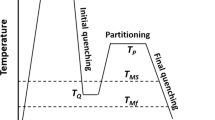Conclusions
-
1.
The use of the similarity theory to analyze the quenching process makes it possible to obtain a generalized quenching graph for oil and water that characterizes the temperature field during cooling of forgings (machine parts) of different diameters.
-
2.
A method was developed for determining the hardenability by means of superposing the quenching graph on the thermokinetic diagram of the steel. This method makes it possible to determine the hardened zone in forgings of different diameters with given requirements (absence of pearlitic transformation, absence of transformation in the upper bainite range, etc.).
-
3.
To obtain high mechanical properties (high strength and low ductile-brittle transition temperature) it is necessary that the cooling time during quenching of large forgings be sufficient to lower the temperature in the center of the forging to 200–300°C.
-
4.
To obtain high mechanical properties due to decomposition of austenite in the martensite transformation range and in the lower bainite range it is expedient to quench large forgings with unvarying section in water or through water in oil.
-
5.
For parts varying in section (barrels and necks) the best method is water-air or sprayer cooling, permitting separate cooling of the barrel and the neck and thus permitting prolonged cooling of the barrel to the required temperature.
Similar content being viewed by others
Literature cited
A. A. Astaf'ev et al., "Selecting steels for large rotor forgings," in: Reports of the All-Union Conference on Progressive Methods of Heat Treating Metals and Alloys [in Russian], Rostov-on-Don (June 2–4, 1971), p. 203.
D. McDowell, Iron Age,165, No. 2, 64–67 (1950).
P. V. Sklyuev et al., in: Heat Treatment and Properties of Large Forgings [in Russian], Mashgiz, Moscow (1959).
H. Burton, The British Journal of Metals, Metallurgia,44, No. 261, 22–28 (1951).
A. Schaffer, Metal Progress,69, No. 4, 63–67 (1956).
R. Matters, R. Lochen, J. Dedinas, and H. Ihrig, J. Metals,8, No. 3, 317–324 (1956).
A. Waine, J. Iron Steel Inst.,165, Part III, 279–286 (1950).
A. A. Astaf'ev, "Effect of microheterogeneities on the kinetics of phase transformations in large forgings of steel 34KhN3M" Metal. i Term. Obrabotka Metal., No. 2, 72 (1971).
H. Garson, Compt. Rend. del Journess de la Grosse Forge, Paris (1948).
A. A. Astaf'ev and K. A. Ermakov, "Logical methods of quenching large forgings of structural steel," Metal. i Term. Obrabotka Metal., No. 4, 35 (1956).
Additional information
The conference was held October 10–12, 1973, in Tashkent. The text of the reports was prepared by the section of metal science and heat treatment of metals of the Central Board of the Scientific-Technical Society of the Machine Construction Industry (NTOMASHPROM).
Central Scientific-Research Institute of Heavy Machine Construction. Translated from Metallovedenie i Termicheskaya Obrabotka Metallov, No. 9, pp. 2–5, September, 1973.
Rights and permissions
About this article
Cite this article
Astaf'ev, A.A. Heat treatment of large forgings. Met Sci Heat Treat 15, 725–728 (1973). https://doi.org/10.1007/BF00656278
Issue Date:
DOI: https://doi.org/10.1007/BF00656278




